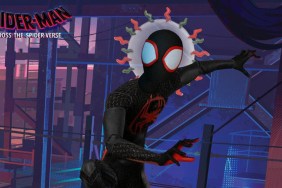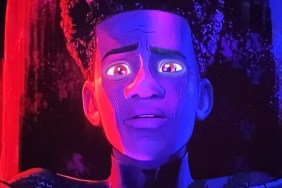It’s ironic for a movie that features as many quick cuts and frenetic, trimmed-to-the-microsecond action sequences as Spider-Man: Across the Spider-Verse, that it’s such slow going at first. An energetic intro featuring Gwen Stacy (Hailee Steinfeld) drumming as she recounts her origin story has some of the finest animation expressing music in a feature film this side of Fantasia, but once the narrative settles back on Miles Morales (Shameik Moore), the movie shifts from beating percussion instruments to beating the viewer over the head with the movie’s major emotional throughline. It’s the same emotional throughline, more or less, of every Spider-Man movie: super powers as a metaphor for coming-of-age, and secret identity as a metaphor for parental figures just not understanding.
Parental Persuasion
It feels a lot like pandering to the parents (and some critics) in the audience. Belaboring the importance of family relationships in a cartoon will often persuade the more animation-unfriendly grown-ups that the film therefore has substance and weight, not like those other ‘toons that are just trying to be fun (Heaven forbid). So Gwen argues with her dad, and Miles argues with his parents, and both wonder if they can trust them with their secrets. Miles and Gwen’s feelings for each other also grow – thankfully, unlike the Star Wars sequel trilogy that instantly put the kibosh on Rey and Finn’s sparks from their first film, the Spider-Verse doesn’t fear interracial dating.

Meanwhile, there’s a comedically awkward villain called the Spot (Jason Schwartzman) doing crimes to get Miles’ attention. Desperate to become an arch-nemesis rather than a “villain-of-the-week,” he initially manages only to be a minor annoyance, but eventually manages to harness the power of multiversal portals to increase his own more awkward and self-generating versions. Kingpin’s giant collider may have been destroyed, but not all its damage undone, and if you’ve seen Marvel’s Loki, you know where this is going. The Spider-Verse now has its own version of the Time Variance Authority, except that they’re all spider-people, and only concerned with maintaining the timelines of other spider-people: “the arachno-human poly multiverse,” as they call it.
Spider-Man, Toxic Fan
Rather than preserving a prime timeline, they specifically refer to their work as keeping canon from breaking, with the idea being that every arachno-human (or horse, cat, dinosaur, or even sentient car) has fixed plot points in their life. A radioactive spider will bite. An uncle must die. A villain battle must kill a beloved police Captain. Et cetera. It’s a meta-joke all comics fans will get, especially when hidden truths about Miles’ origins reveal that he himself is a multiversal anomaly. This Spider-Society are literal gatekeepers, in the pejorative sense, insisting they determine what is and is not canon. And that anything that breaks their canon could destroy the universe. Like the introduction of an Afro-Latino Spider-Man once did for certain closed-minded comic-book guys in our world.

Across the Spider-Verse may otherwise employ obvious narrative tropes – it really wants to be The Empire Strikes Back, and it shows – but thankfully it continues to obliterate visual ones. Outside of Miles’ universe, other realities look rawer and less polished. “Mumbattan” frequently shows buildings only in outlines, while Spider-Man 2099 (Oscar Isaac) still has proportion lines floating around his face. In Gwen’s universe, the world is literally painted in broad brush strokes. When characters show emotion, the walls begin to drip like tears. Then there’s Hobie, a.k.a. Spider-Punk (Daniel Kaluuya), whose body and homeworld resemble the collages of early punk rock fliers and albums, in constant motion.
Styles Clash
Even within the aesthetics of a given dimension, rules can break when the action starts, with subjective points of view, sudden style changes (Miles’ universe may revert to looking like his sketches at any moment), and characters from other universes that don’t match. Japanese anime is more familiar with this kind of expressiveness; it’s unusual for an American animated film to go for broke with clashing styles and distorted perceptions to this degree. Daniel Pemberton returns as primary composer, and his electronics help fuel the caffeinated pace and strobing edits that sometimes make the average TikTok look like Tarkovsky by comparison.

Across the Spider-Verse is trying to be the darker sequel, and perhaps as such, and to its detriment, does not feature jokier characters in primary roles, like Spider-Ham and Spidey Noir in the original. The closest it gets are the Spot, who disappears for much of the movie’s second-half, and Andy Samberg as Spider-Clone Ben Reilly, a parody of grimdark ’90s comics so of course, duh, he’s a gatekeeper. Ben doesn’t get a lot of screen time, but maximizes what he has. Once the most hated Spidey of all time, he’s sure to get a bit of a popularity surge from this.
The Verdict:
Across the Spider-Verse ends on a cliffhanger, making it clearly half a story and tough to properly judge in itself. What’s already clear is that it’s a visual triumph; what’s not is if the narrative will go much beyond the obvious. Its ever-flowing sight gags never fail to elicit a laugh if you catch them quickly enough; its “never let anyone make you feel unimportant” thesis feels like a euphemistic tapdance around more serious issues. Savvy fans will get where it’s coming from, though, and maybe that’s the point. Social commentary of the more overt kind can be a big risk today, and the sarcastic-ish Comics Code Seal of Approval at the film’s beginning should be hint enough to look for what’s hidden.
Grade: 4/5
Spider-Man: Across the Spider-Verse opens in theaters June 2









